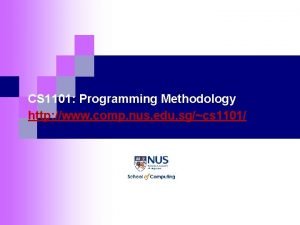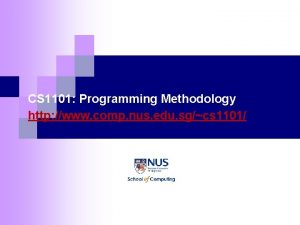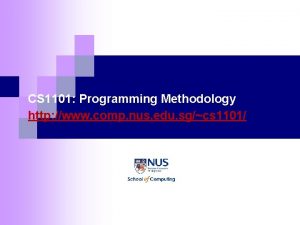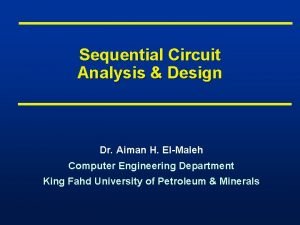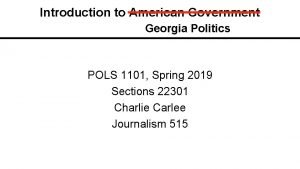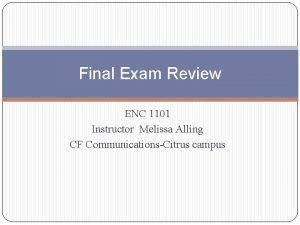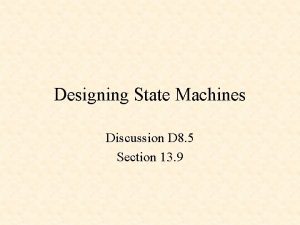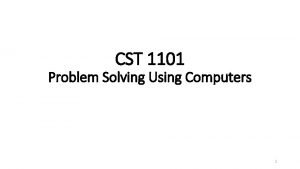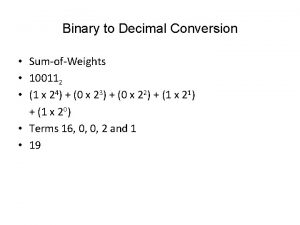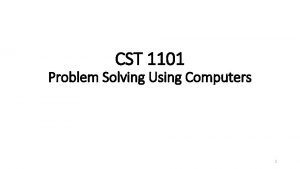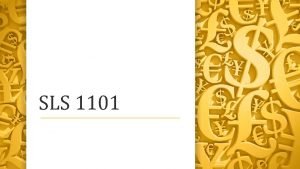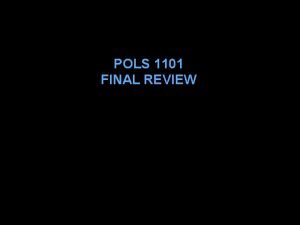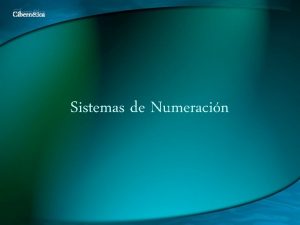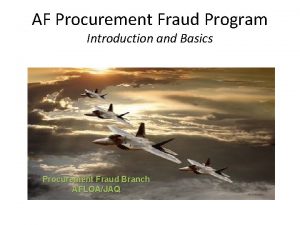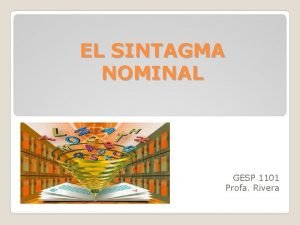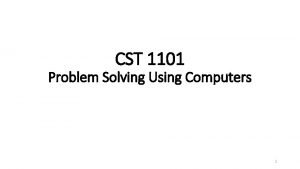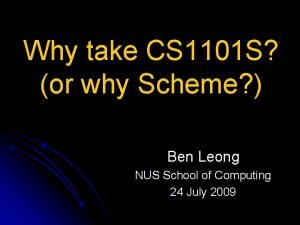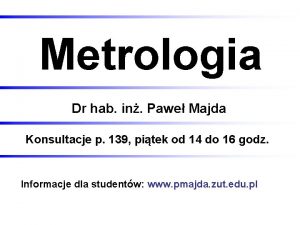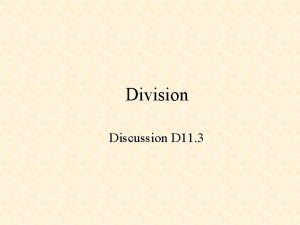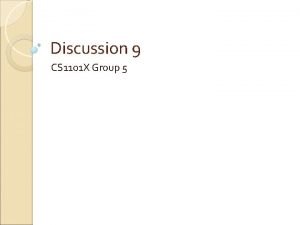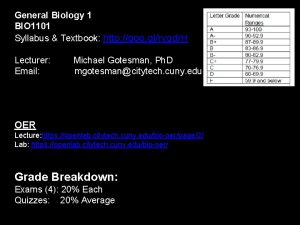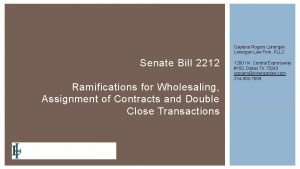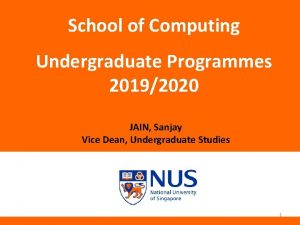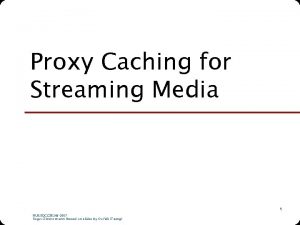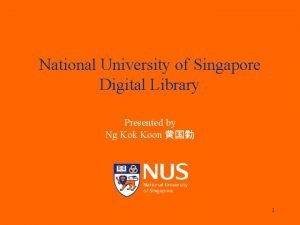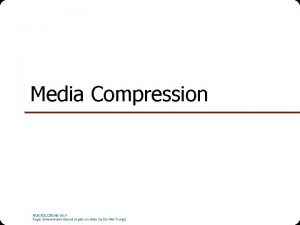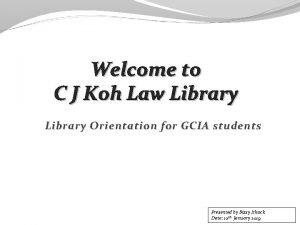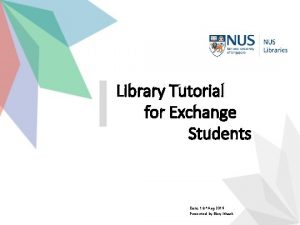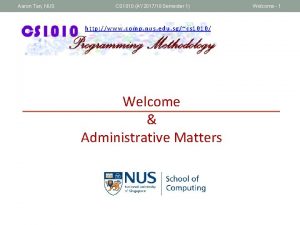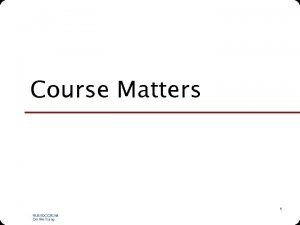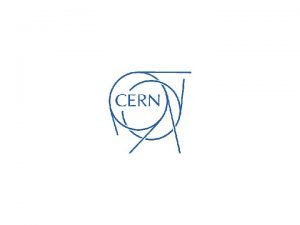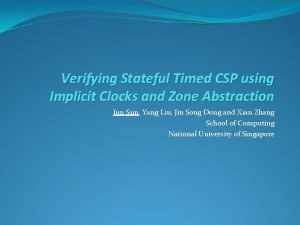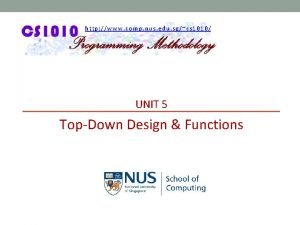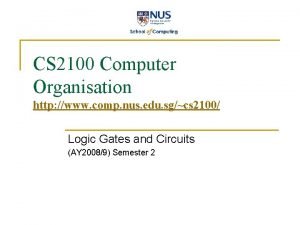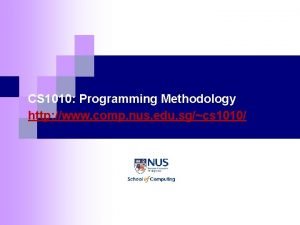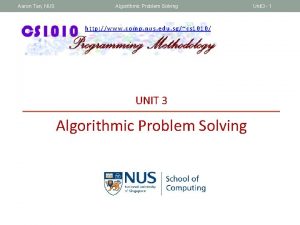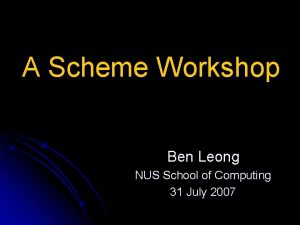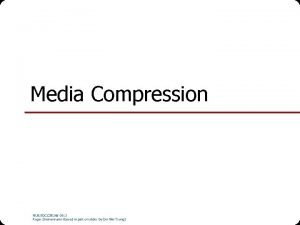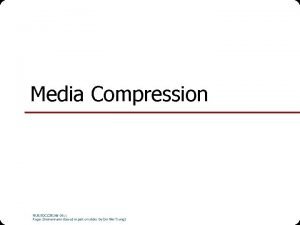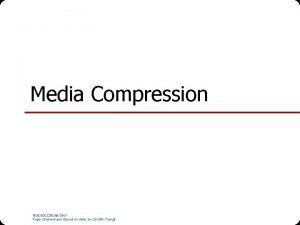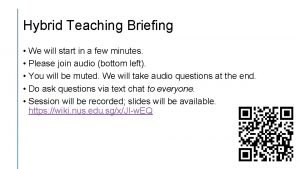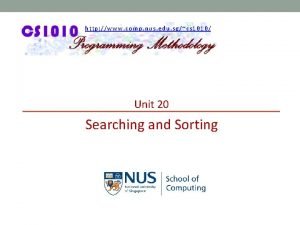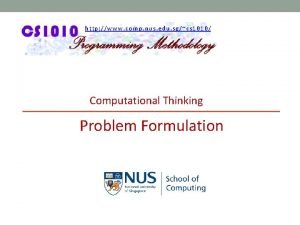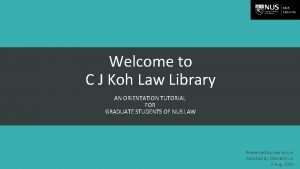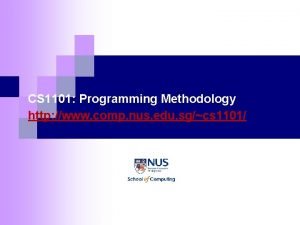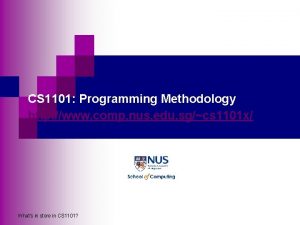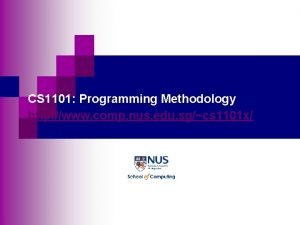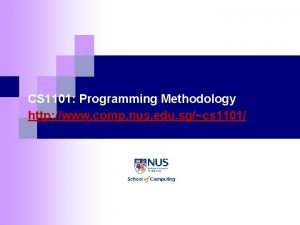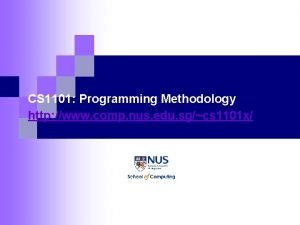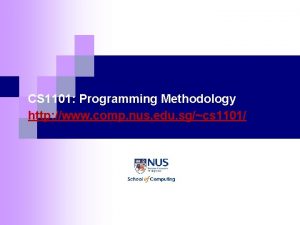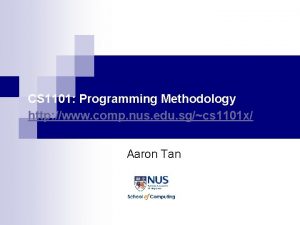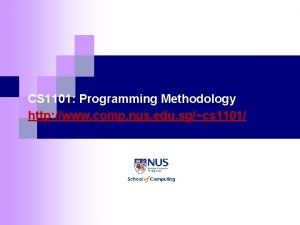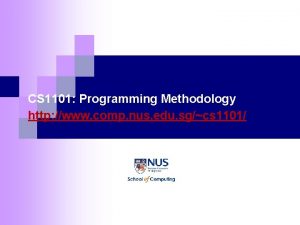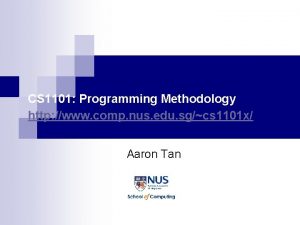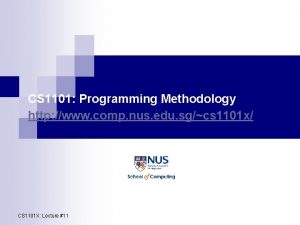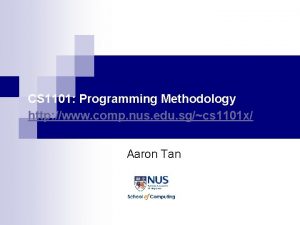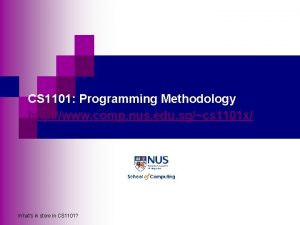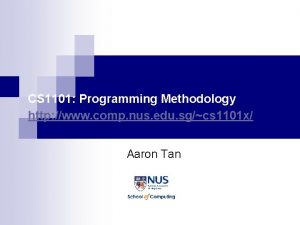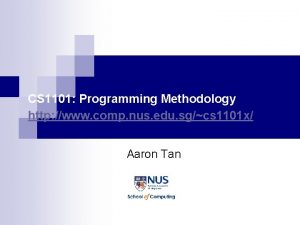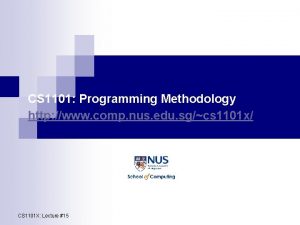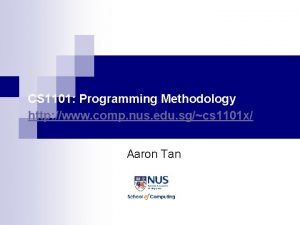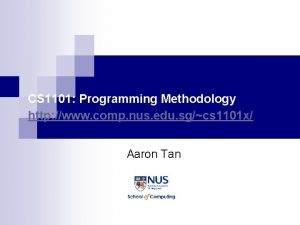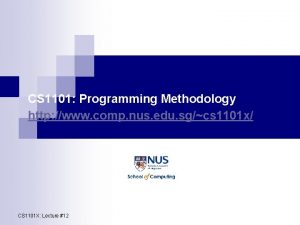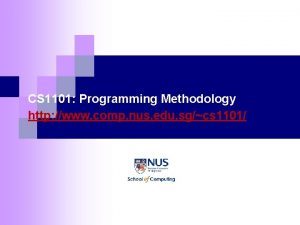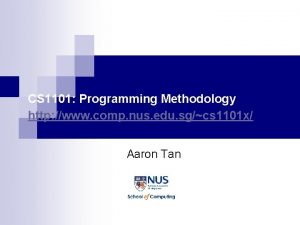CS 1101 Programming Methodology http www comp nus

























































- Slides: 57

CS 1101: Programming Methodology http: //www. comp. nus. edu. sg/~cs 1101 x/ Aaron Tan CS 1101 X Introduction

Week 1: Introduction § § § § History of computers Components of a computer Binary numbers Introduce high-level programming languages Introduce Java programming, compilation and execution. Present useful problem-solving strategies. Writing algorithms in pseudo-codes. CS 1101 X Introduction 2

History of Computers § Websites v ACM Timeline of Computing History (http: //www. computer. org/computer/timeline) v The Virtual Museum of Computing (http: //www. comlab. ox. ac. uk/archive/other/museu ms/computing. html) v IEEE Annals of the History of Computing (http: //www. computer. org/annals/) v and others (surf the web) CS 1101 X Introduction 3

Computers as Information Processors (1/2) § Unlike previous inventions, computers are special because they are general-purpose. v Could be used to perform a variety of tasks. § Computer = Hardware + Software. v Hardware: physical components for computation/processing; should be simple, fast, reliable. v Software: set of instructions to perform tasks to specifications; should be flexible, user-friendly, sophisticated. CS 1101 X Introduction 4

Computers as Information Processors (2/2) Computer are Information Processors Raw data Computer system Processed information Data Units: 1 bit (binary digit): one of two values (0 or 1). 1 byte: 8 bits. 1 word: 1, 2, or 4 bytes, or more (depends on ALU). CS 1101 X Introduction 5

Components of a Computer (1/2) § Main Components: v CPU (Central Processing Unit: controls devices and processes data). v Memory: stores programs and intermediate data. v Input Devices: accept data from outside world. v Output Devices: presents data to the outside world. § An analogy with Human Information Processors: v CPU – brain’s reasoning powers v Memory – brain’s memory v Input Devices – eyes, ears, sensory sub-system v Output Devices – mouth, hands, facial and body expressions CS 1101 X Introduction 6

Components of a Computer (2/2) Headphone (Output) Monitor (Output) Hardware box (contains processor, memory, buses etc. ) Mouse and Keyboard (Input) CS 1101 X Introduction 7

Decimal Number System n n n § Also called the base-10 number system. 10 digits: 0, 1, 2, 3, 4, 5, 6, 7, 8, 9. In general, (anan-1… a 0. f 1 f 2 … fm)10 = (an x 10 n) + (an-1 x 10 n-1) + … + (a 0 x 100) + (f 1 x 10 -1) + (f 2 x 10 -2) + … + (fm x 10 -m) Weighting factors (or weights) are in powers-of-10: … 103 102 101 100. 10 -1 10 -2 10 -3 10 -4 … § Example: 593. 68. The digit in each position is multiplied by the corresponding weight: 5 102 + 9 101 + 3 100 + 6 10 -1 + 8 10 -2 = (593. 68)10 CS 1101 X Introduction 8

Other Number Systems § Binary (base 2): weights in powers-of-2. ¨ Binary digits (bits): 0, 1. ¨ Essential in computing. § Octal (base 8): weights in powers-of-8. ¨ Octal digits: 0, 1, 2, 3, 4, 5, 6, 7. § Hexadecimal (base 16): weights in powers-of 16. ¨ Hexadecimal digits: 0, 1, 2, 3, 4, 5, 6, 7, 8, 9, A, B, C, D, E, F. § Base R: weights in powers-of-R. CS 1101 X Introduction 9

Base-R to Decimal Conversion § (1101. 101)2 = 1 23 + 1 22 + 1 20 + 1 2 -1 + 1 2 -3 = 8 + 4 + 1 + 0. 5 + 0. 125 = (13. 625)10 § (572. 6)8 = 5 82 + 7 81 + 2 80 + 6 8 -1 = 320 + 56 + 2 + 0. 75 = (378. 75)10 § (2 A. 8)16 = 2 161 + 10 160 + 8 16 -1 = 32 + 10 + 0. 5 = (42. 5)10 § (341. 24)5 = 3 52 + 4 51 + 1 50 + 2 5 -1 + 4 5 -2 = 75 + 20 + 1 + 0. 4 + 0. 16 = (96. 56)10 CS 1101 X Introduction 10

Decimal to Binary Conversion (1/2) § Whole number: repeated division-by-2 method. § To convert a whole number to binary, use successive division by 2 until the quotient is 0. The remainders form the answer, with the first remainder as the least significant bit (LSB) and the last as the most significant bit (MSB). (43)10 = (101011)2 CS 1101 X Introduction 11

Decimal to Binary Conversion (2/2) § Fractions: repeated multiply-by-2 method. § To convert decimal fractions to binary, repeated multiplication by 2 is used, until the fractional product is 0 (or until the desired number of decimal places). The carried digits, or carries, produce the answer, with the first carry as the MSB, and the last as the LSB. (0. 3125)10 = (. 0101)2 CS 1101 X Introduction 12

Mathematics § A-level Mathematics assumed. § Common concepts encountered in programming: § prime numbers, complex numbers, polynomials, matrices. Mathematical maturity desirable. CS 1101 X Introduction 13

Software (1/4) n Program ¨ n Execution ¨ n Performing the instruction sequence Programming language ¨ n Sequence of instruction that tells a computer what to do Language for writing instructions to a computer Major flavors Machine language or object code ¨ Assembly language ¨ High-level ¨ CS 1101 X Introduction 14

Software (2/4) n Program ¨ n Execution ¨ n Performing the instruction sequence Programming language ¨ n Sequence of instruction that tells a computer what to do Language for writing instructions to a computer Major flavors Machine language or object code Program to which computer ¨ Assembly language can respond directly. Each ¨ High-level instruction is a binary code that corresponds to a native instruction. ¨ Example: 0001001101101110 CS 1101 X Introduction 15

Software (3/4) n Program ¨ n Execution ¨ n Performing the instruction sequence Programming language ¨ n Sequence of instruction that tells a computer what to do Language for writing instructions to a computer Major flavors Machine language or object code ¨ Assembly language Symbolic language ¨ High-level for coding machine ¨ language instructions. Example: ADD A, B, C CS 1101 X Introduction 16

Software (4/4) n Program ¨ n Execution ¨ n Performing the instruction sequence Programming language ¨ n Sequence of instruction that tells a computer what to do Language for writing instructions to a computer Major flavors Machine language or object code ¨ Assembly language Detailed knowledge of the ¨ High-level machine is not required. Uses a vocabulary and structure closer to the problem being solved. ¨ Examples: Java, C, C++, Prolog, Scheme. CS 1101 X Introduction 17

Translation n n High-level language programs (source programs) must be translated into machine code for execution Translator ¨ n Compiler ¨ n Accepts a program written in a source language and translates it to a program in a target language Standard name for a translator whose source language is a high-level language Interpreter ¨ A translator that both translates and executes a source program CS 1101 X Introduction 18

Java n A high-level object-oriented language developed by Sun. n Two types of Java programs Applet: runs within a web browser. ¨ Application: a complete stand-alone program. ¨ n Java’s clean design and wide availability make it an suitable language for teaching the fundamentals of computer programming. CS 1101 X Introduction Acknowledgement: Cohoon and Davidson 19

Java translation n n Two-step process First step ¨ n Translation from Java to bytecodes n Bytecodes are architecturally neutral object code n Bytecodes are stored in a file with extension. class Second step ¨ An interpreter translates the bytecodes into machine instructions and executes them n Interpreter is known as a Java Virtual Machine (JVM), a program that mimics the operation of a real machine n JVM reads the bytecodes produced by Java compiler and executes the bytecodes CS 1101 X Introduction Acknowledgement: Cohoon and Davidson 20

Task n Ask for user’s name and display a welcome message. Hi <name>. Welcome to CS 1101! CS 1101 X Introduction Acknowledgement: Cohoon and Davidson 21

Sample output Compilation Interpretation Program output CS 1101 X Introduction 22

Welcome. java (1/4) // Author: Aaron Tan // Purpose: Ask for user’s name and display a welcome message. import java. util. *; public class Welcome { public static void main(String[] args) { Scanner scanner = new Scanner(System. in); System. out. print(“What is your name? "); String name = scanner. next(); System. out. println("Hi " + name + ". "); System. out. println("Welcome to CS 1101!n"); } } CS 1101 X Introduction 23

Welcome. java (2/4) // Author: Aaron Tan // Purpose: Ask for user’s name and display a welcome message. import java. util. *; public class Welcome { public static void main(String[] args) { Scanner scanner = new Scanner(System. in); System. out. print(“What is your name? "); String name = scanner. next(); System. out. println("Hi " + name + ". "); System. out. println("Welcome to CS 1101!n"); } These statements make up the action of method } main(). Method main() is part of class Welcome. CS 1101 X Introduction 24

Welcome. java (3/4) // Author: Aaron Tan // Purpose: Ask for user’s name and display a welcome message. import java. util. *; public class Welcome { public static void main(String[] args) { Scanner scanner = new Scanner(System. in); System. out. print(“What is your name? "); String name = scanner. next(); System. out. println("Hi " + name + ". "); System. out. println("Welcome to CS 1101!n"); } } CS 1101 X Introduction A method is a named piece of code that performs some action or implements a behavior. 25

Welcome. java (4/4) // Author: Aaron Tan // Purpose: Ask for user’s name and display a welcome message. import java. util. *; public class Welcome { public static void main(String[] args) { Scanner scanner = new Scanner(System. in); System. out. print(“What is your name? "); String name = scanner. next(); System. out. println("Hi " + name + ". "); System. out. println("Welcome to CS 1101!n"); } } CS 1101 X Introduction An application program is required to have a public static void method named main(). 26

Problem Solving Process (1/3) n n Analysis Design Implementation Testing Determine the inputs, outputs, and other components of the problem. Description should be sufficiently specific to allow you to solve the problem. CS 1101 X Introduction 27

Problem Solving Process (1/3) n n Analysis Design Implementation Testing Describe the components and associated processes for solving the problem. Straightforward and flexible Method – process Object – component and associated methods CS 1101 X Introduction 28

Problem Solving Process (1/3) n n Analysis Design Implementation Testing Develop solutions for the components and use those components to produce an overall solution. Straightforward and flexible CS 1101 X Introduction 29

Problem Solving Process (1/3) n n Analysis Design Implementation Testing Test the components individually and collectively. CS 1101 X Introduction 30

Problem Solving Process (2/3) CS 1101 X Introduction 31

Problem Solving Process (3/3) n Refer also to Jumpstart to So. C on course website, “Misc…”, “For Freshmen”. CS 1101 X Introduction 32

Pólya: How to Solve It (1/2) A great discovery solves a great problem but there is a grain of discovery in the solution of any problem. Your problem may be modest; but if it challenges your curiosity and brings into play your inventive faculties, and if you solve it by your own means, you may experience the tension and enjoy the triumph of discovery. Such experiences at a susceptible age may create a taste for mental work and leave their imprint on mind and character for a lifetime. -- George Pólya CS 1101 X Introduction 33

Pólya: How to Solve It (2/2) n Phase 1: Understanding the problem n Phase 2: Devising a plan n Phase 3: Carrying out the plan n Phase 4: Looking back CS 1101 X Introduction 34

Pólya: How to Solve It (2/2) n Phase 1: Understanding the problem n Phase 2: Devising a plan n Phase 3: Carrying out the plan n Phase 4: Looking back ¨ What is the unknown? What are the data? ¨ What is the condition? Is it possible to satisfy the condition? Is the condition sufficient to determine the unknown? ¨ Draw a figure. Introduce suitable notation. CS 1101 X Introduction 35

Pólya: How to Solve It (2/2) n Phase 1: Understanding the problem n Phase 2: Devising a plan n Phase 3: Carrying out the plan n Phase 4: Looking back ¨ Have you seen the problem before? Do you know a related problem? ¨ Look at the unknown. Think of a problem having the same or similar unknown. ¨ Split the problem into smaller sub-problems. ¨ If you can’t solve it, solve a more general version, or a special case, or part of it. CS 1101 X Introduction 36

Pólya: How to Solve It (2/2) n Phase 1: Understanding the problem n Phase 2: Devising a plan n Phase 3: Carrying out the plan n Phase 4: Looking back ¨ Carry out your plan of the solution. Check each step. ¨ Can you see clearly that the step is correct? ¨ Can you prove that it is correct? CS 1101 X Introduction 37

Pólya: How to Solve It (2/2) n Phase 1: Understanding the problem n Phase 2: Devising a plan n Phase 3: Carrying out the plan n Phase 4: Looking back ¨ Can you check the result? ¨ Can you derive the result differently? ¨ Can you use the result, or the method, for some other problem? CS 1101 X Introduction 38

Algorithmic Problem Solving n An algorithm is a well-defined computational procedure consisting of a set of instructions, that takes some value or set of values, as input, and produces some value or set of values, as output. Input CS 1101 X Introduction Algorithm Output 39

Algorithm n Each step of an algorithm must be exact. n An algorithm must terminate. n An algorithm must be effective. n An algorithm must be general. n Can be presented in pseudo-code or flowchart. CS 1101 X Introduction 40

Euclidean algorithm n First documented algorithm by Greek mathematician Euclid in 300 B. C. ¨ To compute the GCD (greatest common divisor) of two integers. 1. Let A and B be integers with A > B ≥ 0. 2. If B = 0, then the GCD is A and algorithm ends. 3. Otherwise, find q and r such that 4. A = q. B + r 5. where 0 ≤ r < B Note that we have 0 ≤ r < B < A and GCD(A, B) = GCD(B, r). 6. CS 1101 X Introduction Replace A by B, and B by r. Go to step 2. 41

Find minimum, maximum and average (1/3) n Version 1 First, you initialise sum to zero, min to a very big number, and max to a very small number. Then, you enter the numbers, one by one. For each number that you have entered, assign it to num and add it to the sum. At the same time, you compare num with min, if num is smaller than min, let min be num instead. Similarly, you compare num with max, if num is larger than max, let max be num instead. After all the numbers have been entered, you divide sum by the numbers of items entered, and let ave be this result. End of algorithm. CS 1101 X Introduction 42

Find minimum, maximum and average (2/3) n Version 2 sum count 0 // sum = sum of numbers; // count = how many numbers are entered? min ? // min to hold the smallest value eventually max ? // max to hold the largest value eventually } for each num entered, increment count sum + num if num < min then min num if num > max then max num ave sum / count CS 1101 X Introduction 43

Find minimum, maximum and average (3/3) n start Flowchart Terminator box Process box sum count 0 min ? max ? Yes Decision box end of input? No increment count sum + num < min? ave sum/count Yes min num Yes max num No num > max? No CS 1101 X Introduction end 44

Control structures n Sequence n Branching (selection) n Loop (repetition) CS 1101 X Introduction 45

Examples (1/4) n Example 1: Compute the average of three integers. Variables used: A possible algorithm: enter values for num 1, num 2, num 3 ave ( num 1 + num 2 + num 3 ) / 3 print ave num 1 CS 1101 X Introduction num 3 ave Variables used: Another possible algorithm: enter values for num 1, num 2, num 3 total ( num 1 + num 2 + num 3 ) ave total / 3 print ave num 2 num 1 num 2 num 3 total ave 46

Examples (2/4) n Example 2: Arrange two integers in increasing order (sort). Algorithm A: enter values for num 1, num 2 // Assign smaller number into final 1, // larger number into final 2 if num 1 < num 2 then final 1 num 1 final 2 num 2 else final 1 num 2 final 2 num 1 Variables used: num 1 num 2 final 1 final 2 // Transfer values in final 1, final 2 back to num 1, num 2 num 1 final 1 num 2 final 2 // Display sorted integers */ print num 1, num 2 CS 1101 X Introduction 47

Examples (3/4) n Example 2: Arrange two integers in increasing order (sort). Algorithm B: enter values for num 1, num 2 // Swap the values in the variables if necessary if num 2 < num 1 then temp num 1 num 2 temp Variables used: num 1 num 2 temp // Display sorted integers */ print num 1, num 2 CS 1101 X Introduction 48

Examples (4/4) n Example 3: Find the sum of positive integers up to n (assuming that n is a positive integer). Algorithm: enter value for n // Initialise a counter count to 1, and ans to 0 count 1 ans 0 while count <= n do the following ans + count // add count to ans count + 1 // increase count by 1 Variables used: n count ans // Display answer print ans CS 1101 X Introduction 49

Task 1: Area of a circle (1/2) n What is the data? Side of square = 2 a n What is the unknown? Area of circle, C. n What is the condition? If radius r is known, C can be calculated. n How to obtain r? 2 a CS 1101 X Introduction 50

Task 1: Area of a circle (2/2) a n r Pythagoras’ theorem: r 2 = 2 * a 2 a n Area of circle C = * r 2 = * 2 * a 2 CS 1101 X Introduction 51

Task 2: Pascal’s triangle 1 1 1 Compute n. Ck or C(n, k) 1 2 1 n. C = n! / (k! * (n – k)!) 1 3 3 1 k 1 4 6 4 1 1 5 10 10 5 1 CS 1101 X Introduction 52

Task 3: NE-paths n To find the number of north-east paths between any two points. n North-east (NE) path: you may only move northward or eastward. n How many NE-paths between A and C? C A A CS 1101 X Introduction 53

Task 4: Finding maximum n Given three numbers, find the maximum value. ¨ n Example: 4, 7, 3. Answer: 7 Can you extend the algorithm to four numbers, five numbers, in general, n numbers? CS 1101 X Introduction 54

Task 5: Palindrome n A word is a palindrome if it reads the same forward and backward. ¨ n Examples: NOON, RADAR. How do you determine if a word is a palindrome? CS 1101 X Introduction 55

Task 6: Coin change n Given this list of coin denominations: $1, 50 cents, 20 cents, 10 cents, 5 cents, 1 cent, find the smallest number of coins needed for a given amount. You do not need to list out what coins are used. ¨ Example 1: For $3. 75, 6 coins are needed. ¨ Example 2: For $5. 43, 10 coins are needed. CS 1101 X Introduction 56

End of File CS 1101 X Introduction 57
 Cs 1101 programming fundamentals
Cs 1101 programming fundamentals Salute report army
Salute report army Cs-1101
Cs-1101 Cs 1101 programming fundamentals
Cs 1101 programming fundamentals Cs 1101 programming fundamentals
Cs 1101 programming fundamentals Sequence detector 1101
Sequence detector 1101 29 cfr 1926 class asbestps
29 cfr 1926 class asbestps Uga pols 1101
Uga pols 1101 Enc 1101 final exam
Enc 1101 final exam 1101 sequence detector using mealy
1101 sequence detector using mealy Cst 1101
Cst 1101 What is the decimal value of 11012?
What is the decimal value of 11012? Cst 1101
Cst 1101 Sls 1101
Sls 1101 Pols 1101 final exam
Pols 1101 final exam Sistema binario suma
Sistema binario suma Afi 51-1101
Afi 51-1101 Enc 1101 fiu
Enc 1101 fiu Complementos circunstanciales
Complementos circunstanciales Cst 1101
Cst 1101 Dr ben leong
Dr ben leong Iso 1101:2012
Iso 1101:2012 1010 1101
1010 1101 Cs 1101 final
Cs 1101 final Cs 1101 final
Cs 1101 final Bio 1101
Bio 1101 Lonergan law
Lonergan law Perbedaan linear programming dan integer programming
Perbedaan linear programming dan integer programming Greedy vs dynamic programming
Greedy vs dynamic programming System programming
System programming Integer programming vs linear programming
Integer programming vs linear programming Definisi linear
Definisi linear Nus bza curriculum
Nus bza curriculum Nus soc
Nus soc Nus library e resources
Nus library e resources Nus soc ffmpeg
Nus soc ffmpeg C j koh law library
C j koh law library Nus entrepreneurship minor
Nus entrepreneurship minor Nus library catalogue
Nus library catalogue Nus ay 21/22
Nus ay 21/22 Nus soc course schedule
Nus soc course schedule Nus high school timetable
Nus high school timetable Nus
Nus Nus
Nus Nus temperature declaration
Nus temperature declaration Cs2100 nus
Cs2100 nus Cs1010 nus
Cs1010 nus Aaron tan nus
Aaron tan nus Ben leong medium
Ben leong medium Nyjc promotion criteria
Nyjc promotion criteria Nus soc ffmpeg
Nus soc ffmpeg Nus soc ffmpeg
Nus soc ffmpeg Nus ffmpeg
Nus ffmpeg Nus soc ffmpeg
Nus soc ffmpeg Poll everywhere nus
Poll everywhere nus Aaron tan nus
Aaron tan nus Aaron tan nus
Aaron tan nus Nus law library
Nus law library
